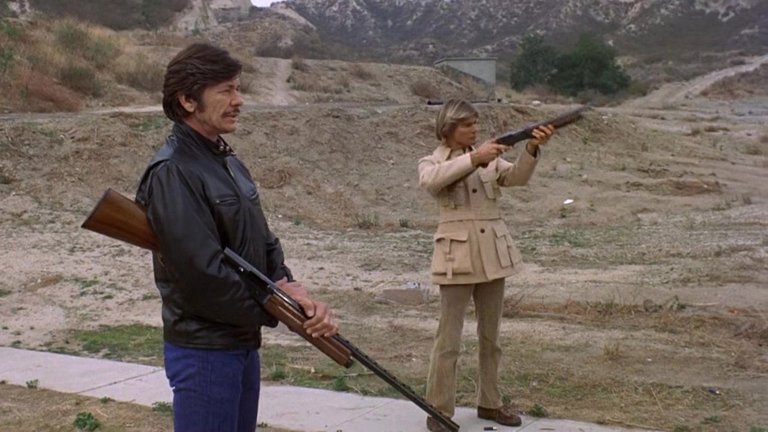Film Review: The Mechanic (1972)

Charles Bronson’s career epitomised the “strong silent type” archetype, a rugged, stoic presence that defined old-school action cinema. His minimal dialogue and physical intensity were the bedrock of his appeal, delivering precisely what 1970s action audiences craved: no-nonsense thrills, moral clarity, and unflinching masculinity. Yet this very persona alienated critics who dismissed his roles as shallow, arguing his characters lacked psychological depth. The Mechanic, a 1972 action thriller, offers an intriguing counterpoint to this critique. Here, Bronson inhabits a morally ambiguous assassin whose detached professionalism and introspective moments reveal unexpected complexity. While far from a masterpiece, the film challenges the notion that Bronson’s work was uniformly one-dimensional, blending visceral action with moments of contemplative tension that elevate it above many of his contemporaries.
In The Mechanic, Bronson plays Arthur Bishop, an elite assassin renowned for transforming his targets’ deaths into plausible accidents. Bishop is financially comfortable yet emotionally barren, his detachment from human connection is both his strength and his burden. After reluctantly killing his father’s old ally, Harry McKenna (Kennan Wynn), Bishop encounters McKenna’s son, Steve (Jan-Michael Vincent), a brash young man eager to join the trade. Recognising Steve’s potential, Bishop takes him under his wing, forging a partnership that initially seems transactional. Their collaboration flourishes during a high-stakes mission in Italy to eliminate a crime boss, though the assignment soon unravels into a labyrinth of betrayal and danger.
The Mechanic distinguishes itself from Bronson’s typical output through its stylistic daring. The film’s opening sequence—a 16-minute silent assassination—sets the tone. Bishop meticulously plans and executes a hit. This extended, dialogue-free scene evokes the minimalist stylings of French New Wave cinema, particularly Melville’s Le Samourai (1967), with its focus on ritualistic preparation and clinical precision. The sequence’s tension derives not from exposition but from the protagonist’s meticulousness, transforming a routine action set piece into a meditation on craftsmanship. Such moments suggest director Michael Winner’s ambition to marry artistry with genre conventions, though the film’s subsequent pacing unevenly balances these aspirations.
Bishop’s emotional isolation is central to his characterisation. Though a remorseless killer, he is curiously introspective, haunted by mortality and the emptiness of his solitary existence. Partnering with Steve is less a choice than a surrender to the inevitability of legacy—a bid to mitigate his own loneliness. Bronson’s performance is restrained but potent, capturing Bishop’s simmering inner conflict. Steve, meanwhile, is no naive apprentice; Vincent’s portrayal renders him as cold, arrogant, and morally bankrupt, contrasting with Bishop’s grudging humanity. Their dynamic becomes a study in contrasts: Bishop’s discipline versus Steve’s recklessness, his controlled fatalism against the latter’s impulsive nihilism. This interplay elevates the film beyond generic action, offering a critique of mentorship and the corrupting allure of violence.
The film’s original script, written by Lewis James Carlino, initially framed Bishop and Steve’s relationship as homosexual—a choice that alienated potential leads like George C. Scott and even Bronson himself. Director Michael Winner, who later collaborated with Bronson on Death Wish, reworked the main characters into heterosexuals, though the changes inadvertently amplified the film’s bleakness. Scenes involving Bishop visiting prostitute (played by Bronson’s real life wife Jill Ireland) and Steve’s girlfriend (played by Linda Ridgeway) staging a fake suicide to retain his affection underscore the narrative’s nihilistic undercurrents. These additions, while jarring, align with the film’s themes of moral decay, suggesting that no character escapes corruption.
For all its stylistic ambition, The Mechanic stumbles in its execution of action sequences. The motorcycle chase and underwater raid on a yacht, while visually audacious, are poorly paced and clumsily directed by Winner. These scenes disrupt the film’s taut, introspective rhythm, feeling more like indulgent set pieces than integral plot developments. The disconnect between the film’s arthouse aspirations and its reliance on flashy action underscores a creative tension between Winner’s artistic ambitions and Bronson’s genre expectations. The result is a disjointed experience: moments of brilliance are undercut by sequences that prioritise spectacle over narrative cohesion.
The film’s power lies in its final act, which delivers a devastating plot twist. Without spoiling specifics, the climax subverts audience expectations, reframing earlier events through a lens of profound betrayal and tragedy. The ending—spare, emotionally resonant, and devoid of Hollywood sentimentality—is a masterstroke, leaving viewers with an indelible sense of futility. This sequence alone justifies the film’s legacy, its bleakness contrasting sharply with the action genre’s typical reliance on catharsis.
The Mechanic was a commercial success, cementing Bronson’s star power and proving that audiences craved stories that balanced action with psychological depth. Despite mixed critical reception film’s influence endured. Its 2011 remake, starring Jason Statham, traded its predecessor’s grit for glossy CGI and diluted its themes, resulting in a hollow, derivative effort. The 2016 sequel, Mechanic: Resurrection, fared no better, underscoring the original’s uniqueness. The Mechanic remains a flawed yet vital entry in 1970s action cinema, a testament to Bronson’s versatility and a reminder that even within the genre’s constraints, artistry can flourish.
RATING: 6/10 (++)
Blog in Croatian https://draxblog.com
Blog in English https://draxreview.wordpress.com/
InLeo blog https://inleo.io/@drax.leo
Hiveonboard: https://hiveonboard.com?ref=drax
InLeo: https://inleo.io/signup?referral=drax.leo
Rising Star game: https://www.risingstargame.com?referrer=drax
1Inch: https://1inch.exchange/#/r/0x83823d8CCB74F828148258BB4457642124b1328e
BTC donations: 1EWxiMiP6iiG9rger3NuUSd6HByaxQWafG
ETH donations: 0xB305F144323b99e6f8b1d66f5D7DE78B498C32A7
BCH donations: qpvxw0jax79lhmvlgcldkzpqanf03r9cjv8y6gtmk9
Posted Using INLEO